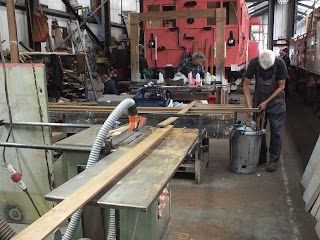Great Eastern Railway 1899 4 Wheel Brake Third 853
Yet more body filling and sanding has been the main exterior focus this week. Despite this being one of those jobs where one doesn't feel like progress is being made, this week has seen the bulk of the preparation declared complete on the landward side.
Whilst it will receive a final fettle after the undercoat has been applied, for now the whole side (considerably flatter than before) has had a full coat of primer and attention will now turn to giving the two ends of the vehicle the same treatment.
On the interior, some painting of the insides of the doors has been done to get them started, and the remaining lock plates for the three passenger doors (one has already been completed as a trial) continue to be produced and/or adjusted as part of their fitting.
London North Eastern Railway 1937 Restaurant Buffet E9128E
The landward side is now very well advanced, with all the new beading now fitted and sealed into place. This side is now completed as far as practicable before painting happens.
Due to access issues, the replacement "Di-bond" lower panels cannot be fitted to seaward side until the coach is swapped onto the adjacent road, so this side remains the same until shunting can be arranged.
The two corridor end doors pictured last week have progressed with their repairs completed. Varnish is now beginning to be applied, a photo will follow once I have caught up with them!
British Railways 1959 Brake Corridor Composite E21224
This week has seen good progress on several fronts. The "rust-kill" priming, pictured last week, has now been completed so the whole of the underframe is rust free for the first time in many years! This has given us the stable base we need to apply the remaining normal coats of paint. The first is the primer which is now being applied at the Holt end of the vehicle heading towards the Sheringham end.
The Sheringham end bogie is now complete sporting a coat of black undercoat.
Meanwhile, off-coach components continue to be restored. A set of footboards for the seaward side of the coach have been stripped, primed and undercoated this week.
The luggage racking continues to be stripped of its netting to allow the aluminium to be cleaned and polished up to its former glory. These are steadily going through one-by-one and will be well worth it once completed.
British Railways 1959 Tourist Second Open M4843
Not so much to picture this week, but both the welding at the Holt end, and the fitting out of the doorways at the Sheringham end vestibule, are both progressing. Inside the vehicle, most of the heater covers under the passenger seats have been repainted, receiving a fresh coat of black gloss as they had not been so treated for many years.
British Railways 1960 Brush Type 2 D5631
This interloper continues to dominate the staged area, as we try to get it as cosmetically advanced as possible before M&GN Members Day in a week's time. The most obvious change has been the paintwork.
By the middle of this week the entire loco made it into undercoat, as previously various parts that were being worked on were lagging behind in terms of how many coats of paint they had had.
This has allowed the application of the first coat of gloss to start. So far, the Holt end cab and 2/3rds of the landward side have been treated, so we are beginning to start to see the final colour/configuration...
Whilst all this is going on there has been lots of paint preparation work to the grills that will be attached soon, as well as fitting of lots of smaller components.
British Railways 1962 12 Ton Box Van B784254
Due to the onset of winter, work will be temporarily stopped on this vehicle for a while, but we hope to feature it's progress once again in these notes at some point.
London Midland Scottish Railway 1947 22 Ton Plate Open 726631
In contrast to last week, we have had a much better run of weather this week which has allowed rapid progress to be made on the repainting of the wagon. The entire outside (body and chassis) has been fully painted into primer so it has taken on a rather pink appearance!
Inside the body, the rusty floor has been rust-killed and grey floor paint has been applied in an attempt to slow down some of the surface corrosion that was evident on the floor which of course has a lot of rain sitting on it throughout the year. The floor looks about 1000 times better than it did!
Next Week & Members Day
Due to a trip away to Essex to play with someone else's Diesel Multiple Units, there will be no Blog next week, during that weekend which coincides with M&GN Members Day on Saturday 6th. A reminder that this day is in fact is open to all, not just members, and that tours will be running at Weybourne sheds throughout the day. This is therefore one of the best opportunities of the year to see the subjects featured in this Blog for yourself, so some on down and have a look round! Additionally, the railway is open at normal fares, which is a great deal considering there are five steam locomotives and a diesel all running!



















































